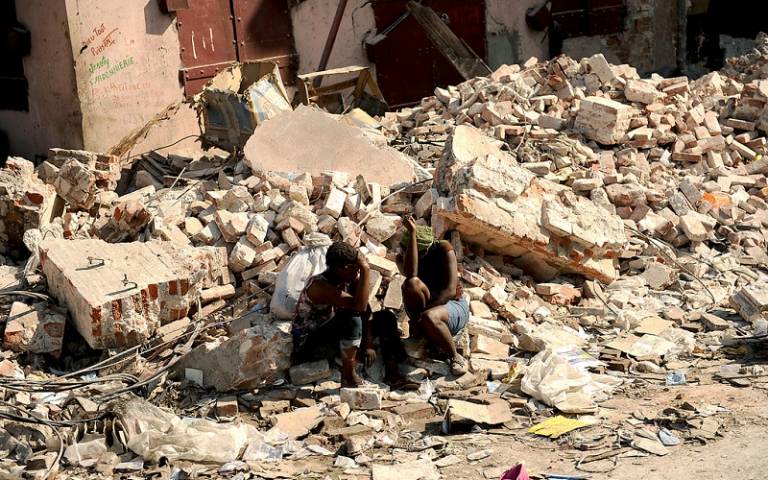What is a Disaster?
10 October 2018
Jake Puddle (MSc Global Governance and Ethics) on a UCL Lunch Hour Keynote Lecture with GGI Advisory Board member Dr Ilan Kelman.

In an era of anthropogenic climate change, and particularly in the wake of the recent Indonesian earthquake that claimed over 2000 lives, debates around disaster risk reduction have highlighted the ongoing controversy surrounding the term ‘natural disaster’.
This was also the focus of a recent Lunch Hour Lecture delivered by Dr Ilan Kelman from the UCL Institute for Risk and Disaster Reduction. Seeking to redefine ‘disaster’ as both a man-made and preventable catastrophe, his talk argued that political figures have deliberately framed recent events as ‘natural disasters’, thereby averting debate from the need for more rigorous and long-term prevention measures.
‘Disasters are not Natural’: Reframing the Discourse
Kelman argued that the popular framing of disasters as ‘natural’ risks accepting their occurrence as something inevitable and unpreventable. Rather, as he illustrated, phenomena such as earthquakes are never primarily responsible for the deaths that follow, but ensuing casualties instead occur as a result of collapsing buildings or infrastructure – which in turn are the consequence of insufficient government planning, investment and regulation. As such, the debate around disasters should focus more heavily on human organisation and behaviour, emphasising the need for pre-emptive policy-making and investment to protect vulnerable communities.
In addition, whereas reportage of disasters tends to brand them as ‘events’, Kelman called for a more nuanced approach that focuses on the long-term ‘process’ of disaster risk management. This strategy engenders a call for greater governmental accountability, particularly regarding the decisions that lead to resources being diverted away from effective prevention measures and technology. In the case of the Indian Ocean Tsunami in 2004, for instance, scant criticism was made of how regional authorities had chosen not to invest in tsunami warning equipment in the years prior to the disaster, despite such technology having been proposed and made available from as early as the 1970s. Contesting the often reactive and ill-funded government strategies that arise in the ‘event’ of a disaster, Kelman thus asserted that attention be shifted to the everyday beliefs and priorities of policy-makers, pressuring them to implement more thorough preventative strategies in higher risk areas.
Climate Change, Disasters and the Urgency of Action
The fallacy of the ‘natural disaster’ becomes particularly poignant in contemporary debates of climate governance, argued Kelman, because climate change does not inherently cause disasters except in the most extreme cases (such as of global warming pushing temperatures beyond a habitable threshold). While the onset of rising sea levels, increased rainfall and other implications of climate change certainly increase the potential hazards to many communities, it is the political response to and preparation for such threats which determines their likelihood of becoming ‘disasters’.
Substantiating this approach into political reality, however, requires a radical shift in the political debate of disaster prevention. Indeed, as one member of the audience commented, criticism of the term ‘natural disaster’ has circulated in scholarship for decades now – so what needs to be done for politicians to listen?
Kelman responded that unprecedented democratic pressure is necessary to shift disaster risk reduction up government agendas. From raising awareness among individuals, through to lobbying governments, and international organisations, a broad politicised movement is required that reassesses disasters as preventable, man-made and unjust. Legitimated through bottom-up democratic pressure, expertise in disaster prevention could therein be more effectively utilised to prepare against the forthcoming hazards and deliver more pre-emptive assistance to vulnerable communities. At a global political level, pressure could furthermore be directed at the United Nations Office for Disaster Risk Reduction (UNISDR), ensuring that members share their knowledge and expertise so as to assist the more vulnerable states, and collaborate to strategize against the ‘large-scale vulnerability challenges’ posed by climate change.
Incentivising Disaster Risk Reduction
In order to incentivise and capitalise on these changes to policy, Kelman asserted that disaster risk reduction experts must help to shift the discussion, ensuring that societies celebrate the instances where disasters do not happen, in addition to criticising occasions where a lack of preparedness results in a loss of lives and livelihoods. While many organisations publish a ‘top ten disasters of the year’ report, for example, no attention is given to the ‘top ten potential disasters averted’.
Kelman argued that better publicising the cost-benefit analyses that determine disaster risk reduction policies could help galvanise more media interest in such success stories. When his own research demonstrated the payoffs of improved disaster risk reduction in Bangladesh, for example, Kelman noted that the report was quickly published by Reuters. While media reports still typically focus on the devastation of disasters that do occur, journalists thus still appear interested in stories that focus on ‘what could have happened?’
Nonetheless, what remains to be seen is how this could be developed into a narrative capable of radically reshaping public understanding of disasters. Building on such ideas – and developing them to shift the decades-old understanding of disasters as ‘natural’ – will therefore remain a significant challenge in disaster prevention research.
 Close
Close


